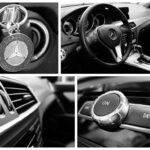Subaru 2.5 Engines: Typical Problems (with Costs)
The Subaru 2.5 engine has been one of their most problematic engines of all time. The 2.5L EJ25 Boxer engine started to show issues in the late 1990s, however, despite multiple stages, Subaru failed to eliminate the problems entirely.
Today we will take a look at Subaru 2.5 engine typical problems and discuss the expected cost to fix them.
What are the Most Common Subaru 2.5 Problems?
The EJ25 2.5L Boxer Turbo engine from Subaru is infamous for oil and coolant leaks along with head gasket failure among many stages.
The EJ25 engine was first introduced in 1996 Legacy 2.5 GT. A revised variant was introduced next year, and the engine stayed in constant development starting from EJ25D in 1996 to EJ259 in 2004.
Over the years, Subaru has used the powerhouse for Impreza, Legacy, Forester, Outback, and Baja. The 2.5L originally proved to be a great engine with an initial model ranging from 150 Hp to turbo-charged engine producing over 300 hp in later variants.
But right from the beginning, this 2.5L powerhouse from a reliable Japanese manufacturer started to show issues. Issues that later forced Subaru to redesign the whole powerhouse. However, for the time the original engine was in use, it showed many problems at multiple stages. Three of which were common among most of them.
Also read: 3 Subaru Engines to Avoid (They Will Ruin You)
1. Subaru 2.5L Head Gasket Problem
The 2.5L issues with the head gasket have been the most prevalent problem leading to leaks and failures. Subaru constantly faced complaints about leaking head gaskets in their 2.5L. Despite changing or repairing, the gaskets would just not hold on and start leaking eventually.
The problem was first noticed in the first-gen 2.5L installed in the Legacy GT, Impreza, Forester, and Outback between 1996-99 models. In these engines, the blown head gasket would cause internal oil leaks, with oil seeping into the coolant overflow compartment or the exhaust. The lack of oil later resulted in engine overheating and stalls.
The same issue was faced in the second-gen 2.5L engine, but this time leaks were external. The problem with the head gasket was in the same model, with both oil and coolant leaks. The bad head gasket problem lasted between 1996-2004 costing an average of $1200-$1500.
Fortunately enough, the newer head gaskets tend to last around 150,000 miles but still have a higher tendency to fail.
2. Subaru 2.5 L Cooling Problem
One major problem with the head gasket failure was that it was really hard to discover unless you look for it. The oil or coolant would leak slowly depositing on the sides. The slow process soon created a lack of oil or coolant, causing the engine to overheat.
As the leaks would be in small quantities, the overheating wouldn’t be noticed till somebody drove over long-distance or mountain areas. With head gasket leaks common in both Phase 1 and Phase 2 of the Subaru 2.5, both faced overheating issues.
In the earlier models, before 2003, overheating was mainly because of coolant leaks. Fixing which would need you to change the head gasket.
But that’s not the only cause. Overheating in the Subaru engine has also been caused due to a failed radiator fan, clogging of the radiator and wear and tear of pressure cycling. The cost of fixing is between $200-$300 for the fan and $300-$400 for radiator replacement.
Also read: Mazda vs. Subaru (Depreciation Compared!)
3. Subaru 2.5L Excessive Oil Consumption
Subaru engines consuming too much oil is not a problem seen only with the 2.5L boxer engines. Obviously, with the head gasket getting blown up and the oil leaking and overheating, there would be more consumption of oil in the EJ25s.
But even after Subaru brought in the new type of gasket and redesigned the camshaft, the issue of excessive oil consumption was still seen in the newer 2010-2018 models.
Unlike normal cars that consumed 1 quart of oil at 1500 miles, the boxer 2.5 was chucking up 1 quart of oil in just 1000-1200 miles.
This problem with the Subaru 2.5L engine also got a class action lawsuit after Subaru’s denial to accept it. The lawsuit covered 2011-15 models of Forester, Outback, Crosstrek, Impreza, and Legacy for over 650,000 Subaru buyers.
Trending Video: How to Easily Bring Back to Life any Old Car Battery and Save Tons of Money (click to watch)
According to Subaru, the cause of the issue was poor oil quality, worn-out piston rings, worn-out gaskets, and high oil pressure. As a solution, Subaru suggested changing the piston rings covered under the vehicle’s warranty.
But at the end of the Lawsuit, Subaru was forced to replace these engines with newly redesigned boxer engines given the Subaru you have is chucking too much oil.
Is the Subaru 2.5 the Worst Subaru Engine?
The Subaru EJ25 has been the most problematic Subaru engine so far.
The 2.5L Boxer engines, especially the earlier models, the EJ251, EJ252, EJ253 are three of the most problematic Subaru engines so far. These engines have greatly affected the reliability of many Subaru cars between the years 1996-2004.
Even after redesigning the 2.5L, the issue with the head gasket, oil leaks, and oil consumption was presumed. As the problem has always been believed to be the engine design. Subaru’s Boxer engines use a horizontal design with the piston laying flat in the cylinder.
This causes the fluid inside the engine to gather around the head gasket which normally would have just drained down. As the gasket deteriorates over 80,000-100,000 miles the fluid starts to seep out causing leaks. The leak then results in a lack of fluid, leading to overheating and stalling. Hence, ruining the reliability of the boxer 2.5L engines.
But not all Boxer engines are bad. The EJ25s made after 2009 had a new style multi-layered steel cylinder-head gasket installed. And after 2012, Subaru redesigned their Boxer engine eliminating most of its flaws.
So while the Subaru 2.5L proved to be the worst engine so far, the ones made before 2009 are ones you need to avoid.
Also read: Are Subarus Reliable? Which Subarus aren’t?
Can You Do Something to Prevent These Problems?
Performing regular maintenance and inspection is the only way to prevent these problems.
One way to avoid facing these issues is by staying away from models before 2009. If you have an older Subaru, and you have over 150,000 miles on it already without such issues, you are in the safe zone.
However, if you have an older Subaru, at around 80,000-100,000 miles, there is a high probability you will face the boxer problems. And the only solution to it is constant maintenance with good quality oil and coolant use.
As mentioned before, Subaru engine leaks are so minor at first, they are hard to detect. Regular maintenance with maintaining oil and coolant levels, inspecting leaks, and fixing warning lights popping on the dashboard is the go-to way to avoid major issues like engine stalling, seizing, overheating, etc.
But if you have already got an issue like overheating and leaks due to the head gasket, it’s better to get it replaced with the multi-layered one to prevent it from happening again.
What are the Better Alternatives to Subaru 2.5 Engine?
The Subaru 2.0L EJ20, 2.2L EJ22, and even the 2.5L EJ257 Boxer engine are the three best 4-cylinder alternatives to the 2.5L Boxer.
Among many Subaru Engines, the EJ20T, which is a turbocharged 2.0L boxer engine, is one of the best Subaru engines ever. These performance-oriented flat-four engines are used in the STI and WRX variants of Impreza.
Originally offering about 197hp @ 6000 RPM, the EJ20T is a favorite among Subaru enthusiasts due to its low aftermarket cost and high boosting ability pushing output to 600-700 HP.
Another great alternative is the 2.2L EJ22 engine. Despite being on the older side, it is an incredibly reliable engine, lasting over 300,000 miles. It had multiple variants ranging from 1989-99 and is used in Legacy and STI variants of Impreza.
One 2.5L Boxer that you can consider is the EJ257, which uses a sequential multipoint fuel injection system. Producing over 300 hp the EJ257 is an engine used in the 2004-08 Impreza, Legacy GT, Outback XT, and Forester XT.
All three engines are a great swap for the 2.5L and are extremely affordable with the majority of their parts locally available in the US.






